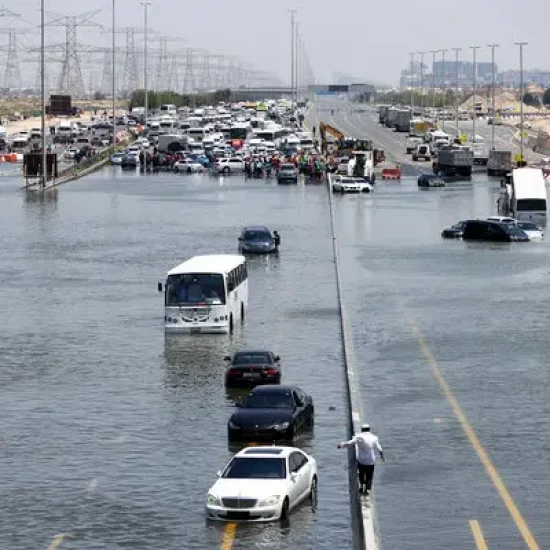 A UN panel on Monday morning released its much awaited report which assessed impacts of climate change on human lives, natural resources and marine ecosystem across the globe. It predicted a gloomy picture for Asia where most of the countries, including India and China, will not only have to face more extreme weather events but also have to experience severe stress on drinking water and food-grains by middle of this century.
A UN panel on Monday morning released its much awaited report which assessed impacts of climate change on human lives, natural resources and marine ecosystem across the globe. It predicted a gloomy picture for Asia where most of the countries, including India and China, will not only have to face more extreme weather events but also have to experience severe stress on drinking water and food-grains by middle of this century.
It more specifically predicted that both India and China will have to see “negative impacts on aggregate wheat yields”, impacting the overall food-security in the continent.
The 49-page report — summary for policy-makers — explained in detail how the global warming would affect most of the countries across the globe where poor, who live at the margin of the societies, will have to suffer the most due to pressure on available natural resources.
For Asia, this report of the Intergovernmental Panel on Climate Change (IPCC) – released in Yokohama, Japan – said that the impact would increase “risk of drought-related water and food shortage causing malnutrition”.
It also predicted increased “riverine, coastal, and urban flooding leading to widespread damage to infrastructure, livelihoods, and settlements, in Asia”. This prediction may well see the impacts of sea-level rise on cities like Mumbai and Kolkata in India and Dhaka in Bangladesh.
Some key predictions for Asia include “Increased risk of heat-related mortality, permafrost degradation in Siberia, Central Asia and Tibetan Plateau, shrinking mountain glaciers across most of Asia, changed water availability in many Chinese rivers and increased flow in four rivers due to shrinking glaciers in the Himalayas”.
“Negative impacts on aggregate wheat yields in South Asia (India, Pakistan and Bangladesh), negative impacts on aggregate wheat and maize yields in China and increase in water-borne disease in Israel” are some other predictions of the IPCC.
The report said “the effects of climate change are already occurring on all continents and across the oceans. The world, in many cases, is ill-prepared for risks from a changing climate”.
It, however, concluded that there are opportunities to respond to such risks, though the risks “will be difficult” to manage with high levels of warming.
The report, titled Climate Change 2014: Impacts, Adaptation, and Vulnerability, from Working Group II of the IPCC, detailed the impacts of climate change to date, the future risks from a changing climate, and the opportunities for effective action to reduce risks.
A total of 309 coordinating lead authors, lead authors, and review editors, drawn from 70 countries, were selected to produce the report. They enlisted the help of 436 contributing authors, and a total of 1,729 expert and government reviewers from different countries including India.
The report identified vulnerable people, industries, and ecosystems around the world. It found that risk from a changing climate comes from vulnerability (lack of preparedness) and exposure (people or assets in harm’s way) overlapping with hazards (triggering climate events or trends). Each of these three components can be a target for smart actions to decrease risk.
Releasing the report, Chris Field, Co-Chair of Working Group II, said, “The report concludes that people, societies, and ecosystems are vulnerable around the world, but with different vulnerability in different places. Climate change often interacts with other stresses to increase risk”.
The Working Group I report was released in September 2013, and the Working Group III report will be released in April 2014. The IPCC Fifth Assessment Report (AR5) cycle will conclude with the publication of its Synthesis Report in October 2014.
R K Pachauri, Chairman of the IPCC, said: “The Working Group II report is another important step forward in our understanding of how to reduce and manage the risks of climate change. Along with the reports from Working Group I and Working Group III, it provides a conceptual map of not only the essential features of the climate challenge but the options for solutions.”
Key points of the IPCC WR-II report:
* In many regions, changing precipitation or melting snow and ice are altering hydrological systems, affecting water resources in terms of quantity and quality
* Glaciers continue to shrink almost worldwide due to climate change, affecting run-off and water resources downstream
* Climate change is causing permafrost warming and thawing in high-latitude regions and in high-elevation regions
* Many terrestrial, freshwater, and marine species have shifted their geographic ranges, seasonal activities, migration patterns, abundances, and species interactions in response to ongoing climate change
* Based on many studies covering a wide range of regions and crops, negative impacts of climate change on crop yields have been more common than positive impacts
* Climate change has negatively affected wheat and maize yields for many regions and in the global aggregate. Effects on rice and soybean yield have been smaller in major production regions and globally
* Climate-related hazards affect poor people’s lives directly through impacts on livelihoods, reductions in crop yields, or destruction of homes and indirectly through, for example, increased food prices and food insecurity
* Freshwater-related risks of climate change increase significantly with increasing greenhouse gas concentrations. The fraction of global population experiencing water scarcity and the fraction affected by major river floods increase with the level of warming in the 21st century
* Climate change over the 21st century is projected to reduce renewable surface water and groundwater resources significantly in most dry subtropical regions, intensifying competition for water among sectors
* Due to sea-level rise projected throughout the 21st century and beyond, coastal systems and low-lying areas will increasingly experience adverse impacts such as submergence, coastal flooding, and coastal erosion
* Some low-lying developing countries and small island states are expected to face very high impacts that, in some cases, could have associated damage and adaptation costs of several percentage points of GDP
* Due to projected climate change by the mid 21st century and beyond, global marine-species redistribution and marine-biodiversity reduction in sensitive regions will challenge the sustained provision of fisheries productivity and other ecosystem services
* Spatial shifts of marine species due to projected warming will cause high-latitude invasions and high local-extinction rates in the tropics and semi-enclosed seas
* Species richness and fisheries catch potential are projected to increase, on average, at mid and high latitudes and decrease at tropical latitudes
* Climate change will impact human health mainly by exacerbating health problems that already exist
* Throughout the 21st century, climate change is expected to lead to increases in ill-health in many regions and especially in developing countries with low income, as compared to a baseline without climate change
* For the major crops (wheat, rice, and maize) in tropical and temperate regions, climate change without adaptation is projected to negatively impact production for local temperature increases of 2°C or more above late-20th-century level



![dubai flood is artificial rain behind uaes rare torrential weather[1]](https://thearabianpost.com/wp-content/uploads/2024/04/dubai-flood-is-artificial-rain-behind-uaes-rare-torrential-weather1-e1713378975696-550x550.jpg)


![2022 09 27T183330Z 84178340 RC2RJV9S1G6M RTRMADP 3 SAUDI POLITICS[1]](https://thearabianpost.com/wp-content/uploads/2024/04/2022-09-27T183330Z_84178340_RC2RJV9S1G6M_RTRMADP_3_SAUDI-POLITICS1-e1712223217759-550x550.jpg)

